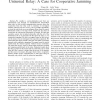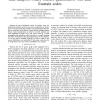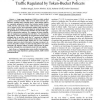GLOBECOM
2008
IEEE
14 years 7 months ago
2008
IEEE
Abstract—Consider a communications system where the detector generates a mix of hard and soft outputs, which are then fed into a soft-input channel decoder. In such a setting, it...
GLOBECOM
2008
IEEE
14 years 7 months ago
2008
IEEE
—We consider a source-destination pair that can communicate only through an unauthenticated intermediate relay node. In this two-hop communication scenario, where the cooperation...
GLOBECOM
2008
IEEE
14 years 7 months ago
2008
IEEE
—We study communication in networks with multiple source-destination pairs and relays. In such networks, the channel output at any destination receiver consists of both the desir...
GLOBECOM
2008
IEEE
14 years 7 months ago
2008
IEEE
—In this contribution, duals of fountain codes are introduced and their use for lossy source compression is investigated. It is shown both theoretically and experimentally that t...
GLOBECOM
2008
IEEE
14 years 7 months ago
2008
IEEE
— In this paper we analyze several protocols for Gaussian half-duplex multiple relay networks where each node either transmits or receives on a particular resource. We present ac...
GLOBECOM
2008
IEEE
14 years 7 months ago
2008
IEEE
—The problem of maximizing the sum of the transmit rates while limiting the outage probability below an appropriate threshold is investigated for networks where the nodes have li...
GLOBECOM
2008
IEEE
14 years 7 months ago
2008
IEEE
— We study the transmission of a stationary ergodic Gaussian source over a packet erasure channel, which is a composite channel with degraded states. A broadcast channel code can...
GLOBECOM
2008
IEEE
14 years 7 months ago
2008
IEEE
Long-range dependence (LRD) is a widely verified property of Internet traffic, which severely impacts network performance yielding longer queuing delays. Moreover, LRD is almos...
GLOBECOM
2008
IEEE
14 years 7 months ago
2008
IEEE
Long-range dependence (LRD) is a widely verified property of Internet traffic, which severely affects network performance yielding longer queuing delays. Token-bucket policers ...
GLOBECOM
2008
IEEE
14 years 7 months ago
2008
IEEE
—For higher streaming quality, a data sender adjusts the data transmission rate according to the network condition between the sender and receiver. The sender and the receiver ex...




